The Best Beginner Rock Climbs in Joshua Tree
Table of Contents
Joshua Tree National Park is one of the world’s most popular climbing destinations. Thousand of cracks, slabs, and boulders, all piled across a vast desert landscape that attracts climbers from across the world. The whole park is rich with history, beauty, and amazing rock climbing.
It would take a lifetime to climb all of the routes in Joshua Tree, and just as long to sort through to find the climbs worth doing. If you’re new to Joshua Tree, I’ve put together this guide to help you find the best easy rock climb that is best for you.
Tips for the Joshua Tree Newcomer
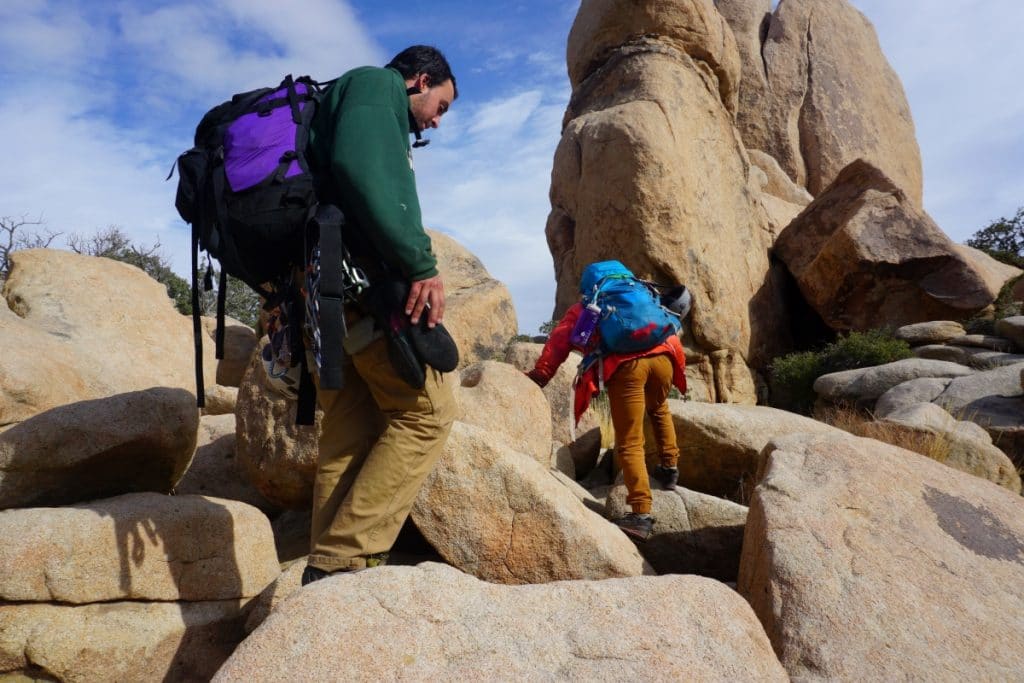
To keep things simple, any climb rated 5.8 or below will be considered an “easy” climb. The style of climbing in Joshua Tree may at first catch some off guard. Slabs and Cracks are de rigeur. It feels nothing like anything found at a gym, or sport climbing crag.
I know this, because I was caught totally off guard by J-Tree’s smooth granite domes. I had no idea how to crack climb, and slab climbing hadn’t even entered my vocabulary. Most of my leads found me scared out of my wits, cursing whichever diety decided to put a rock here.
Yet, I persisted. Soon enough, I found my sea legs. These days, I think that Joshua Tree is the Bees Knees. Keep at it, and you might take a liking to this National Park as well.
Here’s a few things to keep in mind:
- Gear: A trad rack up to 3”. Bring slings to extend pieces, and anchor building gear.
- There are few sport climbs in Joshua Tree. Of the existing sport lines, one can expect to find long, slabby runouts between bolts. It’s a great place to sharpen your mental head game.
- Many of the descents require walk offs on sketchy, 4th class ramps. Approach shoes are recommended.
- Be comfortable with building gear belays, and know how to make them SERENE and ERNEST.
- Many of Joshua Trees best climbs are also the most crowded. Expect to wait in line, or look further to find another route.
Related: The Best Easy Sport Climbs at Red Rocks
1. Double Cross (5.7+)-The Old Woman, Hidden Valley Campground
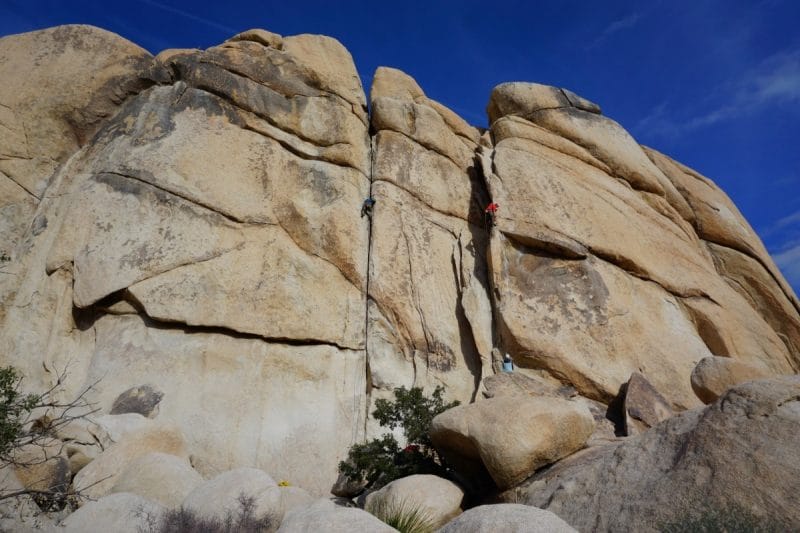
Double Cross, located on Hidden Valley Campground’s Old Woman crag, is the most popular route in Joshua Tree. By far, Double Cross sees more ascents than any other line. A roadside approach, low angle, moderate grade, and bolted anchors ensures that several parties are almost always in line to give Double Cross an attempt.
Despite it’s moderate grade, Double Cross shouldn’t be taken lightly. Thanks to the sheer amount of inexperienced climbers that find their way here, D.Cross sees more accidents than any other climb in Joshua Tree.
The mounting number of rescues has stirred some controversy, prompting an entire thread on the safety and grading considerations needed to climb Double Cross. My two cents: Double Cross isn’t that bad. Just make sure that you have developed solid crack climbing skills, and that you are fine with it’s heady, run out start.
Protection: Double Rack up to 3”. A BD #4 size may help to protect the start.
Bolted Anchors?: Yep!
2. Sail Away (5.8-)-Hidden Tower, Real Hidden Valley

Sitting right in the center of Real Hidden Valley, Sail Away is more than just an overplayed song by Styx. Joshua Tree climbers know it as one of the cleanest, fun moderate hand cracks in the entire park.
Much like Double Cross, Sail Away always seems to have a crowd. Expect to wait in line for a chance at this climb. This is a great route for leaders new to crack climbing. The movement, views, and rests are stellar, and any tricky move is easily protected.
Don’t want to wait in line? Cruise up some of the other awesome moderates nearby. Alternatively, head on over to Leaping Leaner just a few formations over.
Protection: Rack up to 2”.
Bolted Anchors?: Yep! Descend via rappel.
3. Leaping Leaner (5.7)-Locomotion Rock, Real Hidden Valley
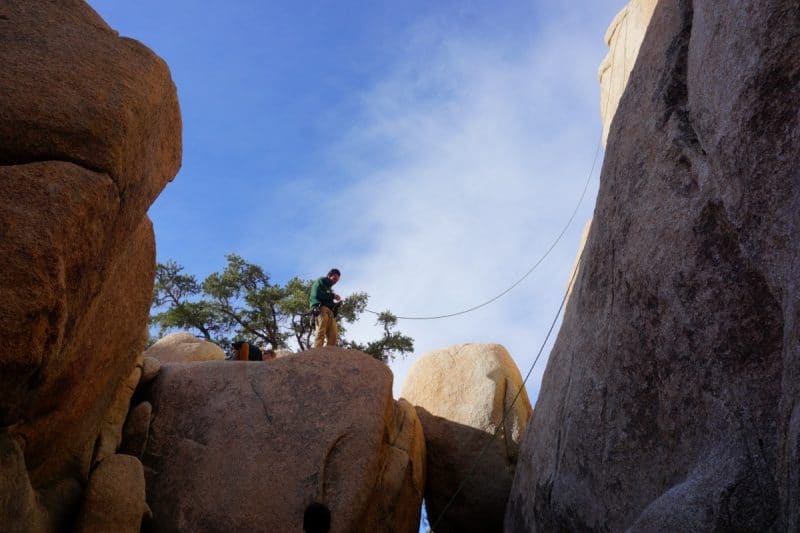
Being one of the most crowded routes in J-Tree, Sail Away is not always accessible. If you don’t want to wait in line, Leaping Leaner is a solid alternative, located just a few minutes walk away.
Leaping Leaner follows a left leaning hand crack to a notch on top of Locomotion Rock. The climb begins with a slabby unprotected start, before coming to a cruiser crack. Leaner is similar to Double Cross, but without the crowds.
According to lore, leaders on Leaping Leaners would begin the climb by jumping from the lip of a large boulder at the start of the climb. Those who stuck the jump would start right into the hand crack. If you missed, you suffered a nasty fall.
I don’t recommend this. Do the jump on top rope instead, as my party did.
Protection: Rack up to 3”. MoPro recommends double hand sizes for new leaders.
Bolted Anchors?: Yep!
4. SW Corner (5.6)-Headstone Rock, Ryan Campground
A Rare Joshua Tree Sport Climb
Named for it’s distinctive shape, Headstone Rock is a stone’s throw from Ryan Campground. A prominent point, Headstone Rock can be climbed via a number of routes. The easiest, most popular, and downright classic summit line is the Southwest Corner.
SW Corner is a rare Joshua Tree Sport climb-a unicorn in an alien landscape full of nothing but slabs and cracks. Please Note: I use the term “sport climbing” loosely here. This is not a grid bolted limestone wall. With four bolts spread out over 70 feet, expect long runouts.
Nevertheless, SW Corner will challenge your head game. Like any other climb in Joshua Tree, this route will challenge your head game. Rather than cleaning the route, bring your partner up, and then descend via a rappel.
Protection: 4 bolts. Some small placement exists to ease the runouts.
Bolted Anchors?: Yep! Descend by Rappelling off of one of two anchors.
5. The Eye (5.4)-The Cyclops, Hidden Valley Campground

Ascending an east facing cleft, The Eye is a well traveled route just across the way from Hidden Valley Campground. Big, friendly holds, and a series of cracks make The Eye one of the most laid back routes in Joshua Tree.
The climb ends at a cave (The Eye) with great views of Hidden Valley Campground. This is a popular spot for many climbers to relax, hang out, and maybe enjoy a cold drink (or three).
The Eye is a great introduction to Joshua Tree Climbing. It is long, easily approached, and more gentle than nearby climbs.
Protection: Rack up to 3”.
Bolted Anchors?: No. Gear Belay. Walk off descent.
6. Toe Jam (5.7)-The Old Woman, Hidden Valley Campground

When Double Cross is crowded, Toe Jam is a great climb locatd just around the corner. Though not a pure, clean crack line, Toe Jam combines the best parts of Joshua Tree climbing into one package.
Toe Jam starts up a crack, before entering right leaning flake. Lay back up a slab to the finger crack crux, and finish at a gear belay on top of the climb. Simple sounding enough, but Toe Jam gave me a lot of trouble. For one, it was the first route that I attempted in Joshua Tree.
I had no idea how to crack climb, instead attempting to face climb through the final finger crack crux. A humbling, yet formative experience.
Also, Toe Jam is right in the middle of the Hidden Valley Campground. You can hop out of your tent, get on Toe Jam, and get right back to camp just as the coffee is pouring.
Protection: Double Rack up to 3”.
Bolted Anchors?: No. Belay off of a gear anchor. Descend by rappelling off of a 2 bolt anchor located 20 feet to the right.
Related: The Best Single Pitch and Top Ropes in Yosemite
7. Right On (5.6)-Saddle Rocks, Sheeps Pass

Multipitch Fun!
You know what they say: It’s not about the size of the routes, its how you climb them. Well, that’s how Joshua Tree rationalizes things.
There are few routes in Joshua Tree longer than 100 feet. Climbers looking to get up big mountains will have better luck in Yosemite or Red Rocks. Multi Pitch climbs in Joshua Tree is almost as rare as the sport climbing, but it does exist.
Enter Right On. At 4 pitches, and 350 feet, it might scratch your itch for bigger climbs. Easily approached and descended, parties can start on Right On after breakfast, and have lunch on the summit.
Right On follows a series of Slabs and Cracks to ascend a prominent dome off the west shoulder of Ryan Mountain. Though this climb is not too difficult, remember that this is Joshua Tree we’re talking about. Parties should expect run out slab, and flared cracks. I recommend this route if you feel that you are a solid 5.8 trad leader.
Protection: Hefty rack up to 3”. Long slings to extend pieces.
Bolted Anchors?: Pitches 1 and 2 use bolted anchors. Pitches 3 and 4 are gear belays. Descend off of back side via a two bolt rappel anchor.
8. Dolphin (5.7)-Isles in the Sky, Split Rocks
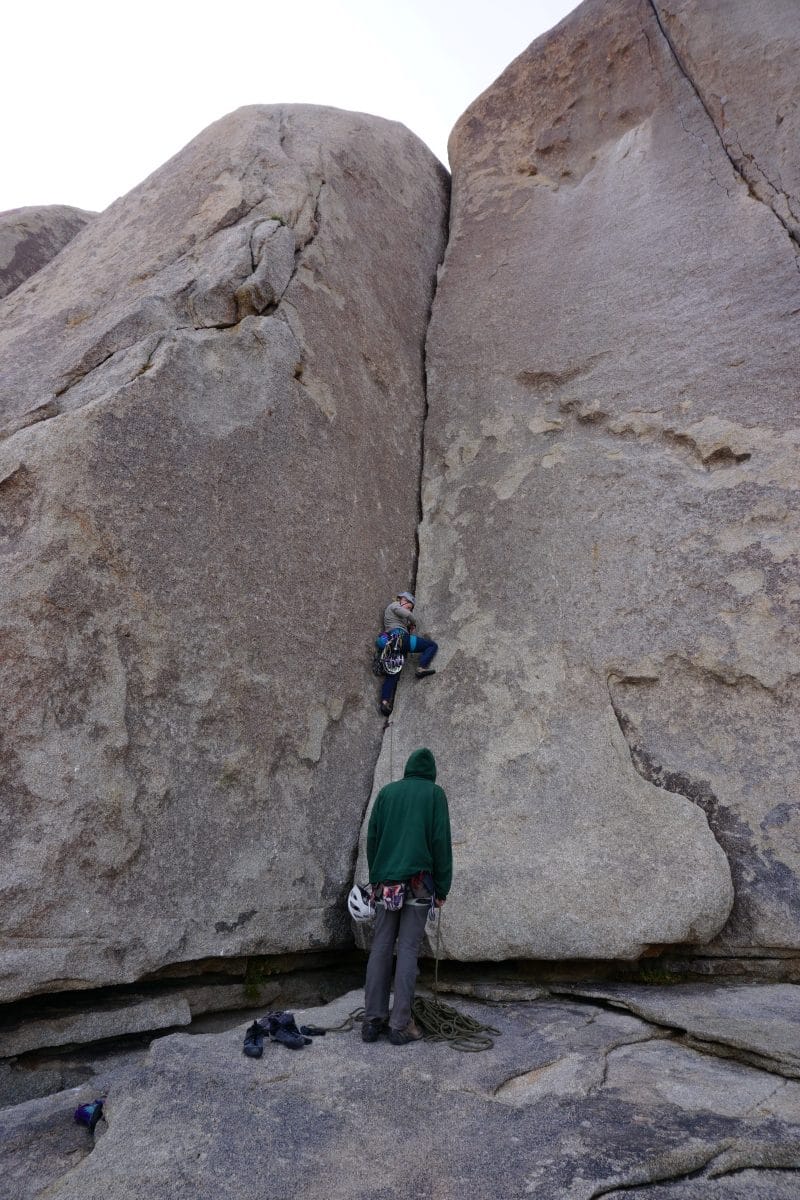
Offwidth. It’s a bad word. Even some veteran trad daddies grimace at the sound of it. Climbing wide cracks is a dirty, hopeless profession, but someone has to do it. The cursed souls that chase these beasts are only running away from something dark.
Well, that’s a bit dramatic. Offwidths, I’m saying, are generally disliked by many climbers. Even the “easy” off width climbs are avoided.
Dolphin, a centerpiece of Split Rocks, starts easy enough. Climbers are lulled into a false sense of security by a friendly hand crack. Don’t get too comfy. At the 40 foot mark, things begin to widen, and climbers quickly become acquainted with Dolphin’s reputation.
Widening from fists, right up through squeeze chimney, Dolphin will test all of your offwidth techniques. Pro Tip: There are no good offwidth techniques.
Expect to leave behind a layer of skin, but emerge with a newfound love (or hate) of offwidth climbing.
Protection: Standard Rack up to a BD #5, or equivalent. Two #5’s recommended.
Bolted Anchors?: Yes. Descend via rappel, or walk off down a 4th class ramp.
9. Overhanging Bypass (5.7, 2 Pitches)-Intersection Rock, Hidden Valley Campground
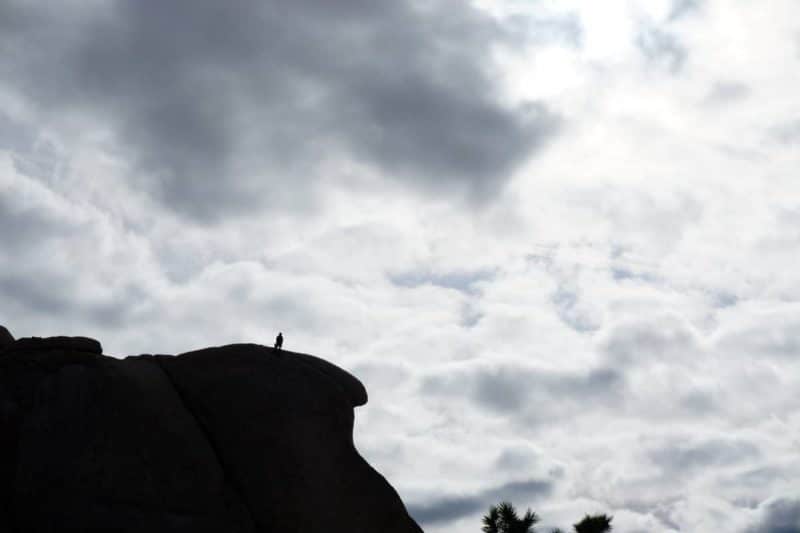
As one of my first climbs in Joshua Tree, memories of Overhanging Bypass are a fond marker in my climbing career. Overhanging Bypass is where I first learned to crack climb and build gear anchors, and thus represents the point where I was converted to trad climbing. Where I was once a free spirited Sport Climber, I am now a grumpy, elitist trad climber.
Overhanging Bypass climbs two pitches on Intersection Rock’s west face. Climbers begin by making their way up a long crack and slab system, before coming to a prominent roof. Build a gear belay, and then traverse right on an airy jug rail. Place a piece to protect your follower before pulling onto the slab around the corner. Continue up the slab to a bolted anchor, and rappel from here.
Overhanging Bypass is a fun, short multi pitch combining a variety of skills and climbing techniques common in Joshua Tree.
Protection: Double rack up to 3”.
Bolted Anchors?: Gear belay below roof for first pitch. Bolted anchors atop Intersection Rock. Descend via Rappel off of the north side of the formation.
Conclusion
This list does not even scratch the surface of the sheer amount of climbing to be found in Joshua Tree National Park. These Climbs only represent a fine introduction. I encourage you to go off and search out Joshua Tree’s hidden gems. They’re everywhere, I assure you.

- The Best Campsites Around Big Bear California - February 26, 2021
- Hiking to the Hollywood Sign Via the Brush Canyon Trail - July 13, 2020
- Dirt Cheap Hiking and Backpacking Gear: The Most Affordable Gear on the Internet - July 4, 2020
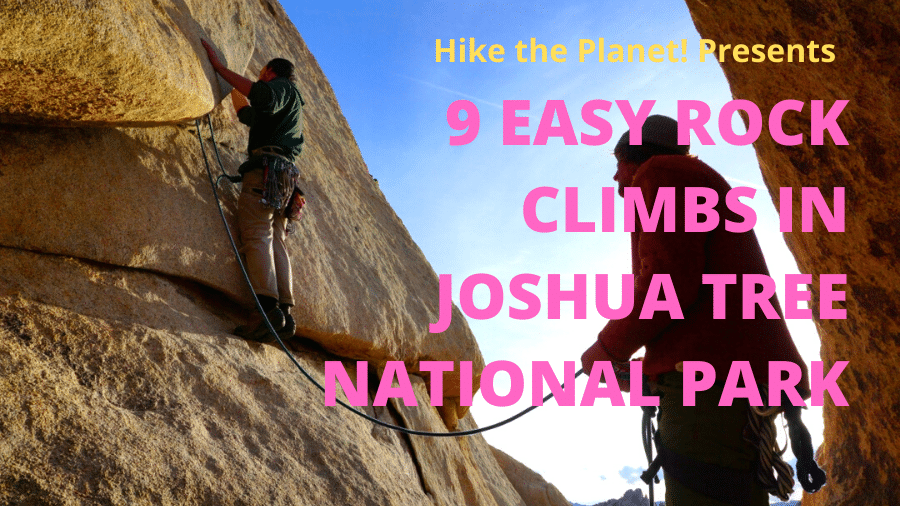
2 thoughts on “The 9 Best Easy Climbs in Joshua Tree National Park”
Comments are closed.